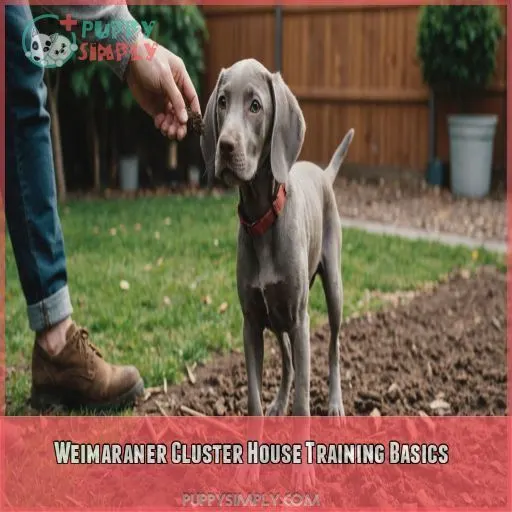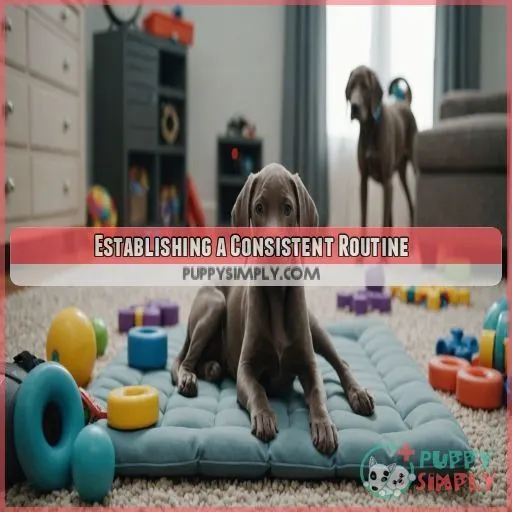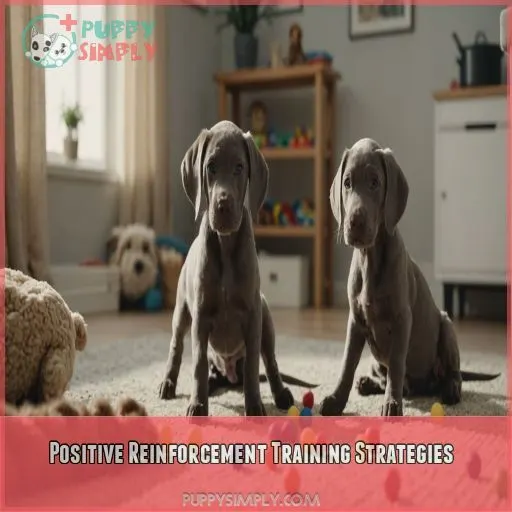This site is supported by our readers. We may earn a commission, at no cost to you, if you purchase through links.

House training Weimaraners requires understanding their high-energy, strong-willed nature and tapping into their intelligence.
It’s not about being a drill sergeant, but about setting clear boundaries, creating a structured environment, and using positive reinforcement techniques.
With consistency, patience, and a dash of humor, you can conquer Weimaraner cluster house training.
Table Of Contents
- Key Takeaways
- Weimaraner Cluster House Training Basics
- Establishing a Consistent Routine
- Weimaraner-Specific House Training Challenges
- Positive Reinforcement Training Strategies
- Maintaining Progress and Overcoming Obstacles
- Frequently Asked Questions (FAQs)
- How long does Weimaraner house training typically take to complete?
- What are the most common Weimaraner house training mistakes owners make?
- How can I prevent Weimaraner separation anxiety during house training?
- Can Weimaraner puppies learn to use litter boxes or pads?
- What role does crate training play in Weimaraner house training?
- Conclusion
Key Takeaways
- You’ve got a smart cookie on your hands – Weimaraners are one of the top 10 most intelligent breeds, after all! To master Weimaraner cluster house training, focus on setting clear boundaries, creating a structured environment, and using positive reinforcement techniques. Consistency and patience are key, so stick to a schedule and reward good behavior.
- Don’t let separation anxiety get the best of you and your Weimaraner! Establish a consistent routine, crate train, and leave a familiar object with your scent to comfort your furry friend. With time and practice, you’ll help your Weimaraner feel more secure and calm when you’re away.
- Weimaraners are high-energy dogs that thrive on structure and routine. To keep them happy and tired, provide a daily exercise routine with at least one hour of physical activity, engage in high-energy play like fetch or agility, and create safe outdoor areas for off-leash playtime. A tired Weimaraner is a happy Weimaraner!
- Accidents will happen, but don’t let them get you down! Instead, use them as an opportunity to learn and improve your training approach. Identify the root cause of the issue, adjust your routine or supervision as needed, and remember to reward good behavior. With time and practice, you’ll overcome those pesky housebreaking hurdles and achieve a pee-free home.
Weimaraner Cluster House Training Basics
You’re about to start your journey with your Weimaraner cluster, and house training is the first hurdle to overcome. By understanding your Weimaraners’ unique temperament and intelligence, setting clear boundaries, and using positive reinforcement techniques, you’ll be well on your way to a pee-free home and a happier, healthier relationship with your furry friends.
Understanding Weimaraner Temperament and Intelligence
As a Weimaraner owner, you’re likely aware of their strong prey drive and high energy levels. Understanding their temperament and intelligence is key to successful house training. Weimaraners are bred for hunting and thrive on structure and routine. By tapping into their natural instincts and providing positive reinforcement, you can overcome common training challenges and raise a well-behaved companion.
Setting Clear Boundaries and Expectations
When you start house training a Weimaraner cluster, setting clear boundaries and expectations is important. Establish consistent rules and routines to avoid confusing your furry friends. Here are some essential boundaries to set:
- Designate a safe space for relaxation and quiet time
- Practice leash manners to prevent pulling and tugging
- Utilize crate training for housetraining and reducing separation anxiety
- Prioritize puppy socialization for a well-adjusted and calm Weimaraner
Creating a Structured Environment for Training
Let’s set the stage for successful Weimaraner cluster house training! Create a structured environment by designating safe, quiet areas for relaxation and play. Identify specific potty spots outside, like a grassy patch or puppy pad. Consider crate training to help with housetraining and reduce separation anxiety. Consistency is key, so stick to a schedule and reward good behavior.
Positive Reinforcement Techniques for Weimaraners
You’re about to harness the power of positive reinforcement on your Weimaraner! With treats, clicker training, and genuine praise, you’ll encourage good behavior and strengthen your bond. Consistency and patience are key, so stick to your routine and reward those small victories. Your Weimaraner will thrive on the attention, and you’ll be well on your way to a pee-free home.
Avoiding Common House Training Mistakes
- Overcorrection, which can create anxiety and make training harder
- Inconsistent timing, leading to confusion and more accidents
- Insufficient crate training, giving your Weimaraner too much freedom too soon
Establishing a Consistent Routine
When you start house training your Weimaraner cluster, establishing a consistent routine is your secret sauce to a pee-free home. By creating a schedule that balances feeding, exercise, and potty breaks, you’ll be well on your way to raising well-behaved Weimaraners that’ll make you proud – and keep your carpets stain-free.
Creating a Schedule for Feeding, Exercise, and Potty Breaks
Your Weimaraner’s schedule is key to a pee-free home! Establish a routine that includes regular feeding times, exercise sessions, and potty breaks. For puppies, this means every hour, while adult Weimaraners can go every 4-6 hours. Consider your dog’s age, size, and energy level when creating a schedule that works for you and your furry friend.
Designating Potty Areas and Cleaning Up Accidents
Now that you’ve got a schedule in place, it’s time to designate potty areas and tackle those inevitable accidents. Choose a specific spot outside, like a grassy patch or puppy pad, and make it easily accessible. For indoor mishaps, keep enzyme cleaners on hand to banish lingering scents that might attract repeat offenders – and don’t forget the carpet!
Gradually Increasing Freedom and Privileges
As you establish a consistent routine, it’s important to gradually increase freedom and privileges for your Weimaraner. Here are four ways to do it:
- Start by giving more playtime outside of the crate
- Introduce new rooms or areas for supervised play
- Increase off-leash time in secure areas
- Gradually phase out crate training as confidence builds.
Managing Multiple Weimaraners With Different Needs
Managing multiple Weimaraners with different needs can be a juggling act, but with a solid plan, you’ll keep everyone on track. Consider each dog’s age, personality, and training level when creating potty schedules. Pack dynamics also play a role, so make sure each dog has individual time and attention. With patience and flexibility, you’ll master the art of multi-Weimaraner management.
Adjusting the Routine for Puppies and Senior Dogs
Now that you’ve mastered managing multiple Weimaraners, let’s talk age-specific needs. For puppies, potty breaks every hour are a must, with 18-20 hours of sleep per day. Senior dogs, on the other hand, need more frequent breaks due to declining mobility. Adjust your schedule to accommodate these needs, and remember, consistency is key to a pee-free home.
Weimaraner-Specific House Training Challenges
As you tackle Weimaraner cluster house training, you’ll inevitably encounter breed-specific challenges that can test your patience and creativity. From separation anxiety and destructive behavior to high energy levels and pesky barking, we’ll explore the most common obstacles and provide you with practical strategies to overcome them and achieve a pee-free home.
Addressing Separation Anxiety and Destructive Behavior
Now that you’ve got a solid routine going, it’s time to tackle those pesky separation anxiety issues that can lead to destructive behavior. Weimaraners can get anxious when left alone, so try crate training, calming techniques like pheromone diffusers, and enrichment activities like puzzle toys filled with treats to keep them occupied and calm while you’re away.
Managing High Energy Levels and Exercise Needs
With a Weimaraner, you’re in for a wild ride! Managing their high energy levels and exercise needs is really important for successful house training. Here’s how to keep them happy and tired:
- Provide a daily Weimaraner exercise routine with at least 1 hour of physical activity
- Engage in high-energy play like fetch, agility, or running
- Create safe outdoor areas for off-leash playtime
- Incorporate breed-specific activities like hunting or scent work for mental stimulation
Dealing With Accidents and Setbacks
Don’t worry about inevitable accidents – they’re an opportunity for growth!
When dealing with setbacks, remember that consistency is key.
Take a deep breath, clean up the mess, and try to prevent it from happening again.
Practice patience and understanding, and remind yourself that your Weimaraner is still learning.
Manage your stress, and you’ll be back on track in no time.
Preventing Escapes and Bolting
To prevent escapes and bolting, consider these essentials:
- Make sure your fence height is at least 6 feet to deter jumping.
- Practice leash training to help your Weimaraner learn to walk calmly by your side.
- Create an escape-proof yard by securing gates and identifying potential bolting triggers, such as squirrels or loud noises.
Minimizing Barking and Whining
Tune in to your Weimaraner’s vocal cues – are they barking due to boredom, anxiety, or alerting you to something? Once you identify the triggers, you can start working on solutions. Use calming techniques like massage, exercise, or quiet cues to help them chill out.
| Barking Triggers | Whining Solutions |
|---|---|
| Boredom | Engage in play or provide puzzle toys |
| Anxiety | Offer a calming massage or pheromone diffuser |
| Alerting | Teach a "quiet" cue and reward calm behavior |
| Attention-seeking | Ignore the behavior and reward calmness |
Positive Reinforcement Training Strategies
You’re ready to tap into the power of positive reinforcement training for your Weimaraner cluster, and it’s about to get a whole lot easier (and pee-free!). With these strategies, you’ll learn how to harness the energy and intelligence of your Weimaraners to create a harmonious, well-behaved household where good habits thrive and accidents disappear.
Using Treats, Praise, and Affection for Good Behavior
Now that you’ve tackled those Weimaraner-specific house training challenges, it’s time to focus on the good stuff!
Using treats, praise, and affection is a powerful way to encourage good behavior.
By setting up a reward system, you’ll motivate your Weimaraner to make those potty breaks outside and those calm moments inside.
Positive reinforcement is key – so be generous with those treats and snuggles!
Implementing Clicker Training for Weimaraners
Now that you’ve mastered using treats, praise, and affection to encourage good behavior, it’s time to level up with clicker training! This technique helps Weimaraners associate a distinct sound with rewards, speeding up the learning process. Here are three clicker training basics to get you started:
- Choose the right clicker: Select a clicker that’s easy to use and has a distinct sound.
- Set up a reward system: Pair the clicker sound with treats and praise for desired behaviors.
- Practice consistently: Click and reward your Weimaraner for good behavior, even in distracting situations.
Teaching Basic Commands and Obedience
Now that you’ve got clicker training under your belt, it’s time to teach your Weimaraner basic commands and obedience. Start with simple commands like "sit," "stay," and "come." Be consistent, patient, and positive, and remember to reward good behavior. Use the following table to get started:
| Command | Hand Signal | Reward |
|---|---|---|
| Sit | Palm up, fingers closed | Treat and praise |
| Stay | Palm out, fingers spread | Treat and praise |
| Come | Arms open, big smile | Treat and praise |
Keep training sessions short and fun to keep your Weimaraner engaged and motivated.
Encouraging Good Habits and Preventing Bad Ones
You’re making great progress with your Weimaraner’s house training.
Now, it’s time to encourage good habits and prevent bad ones.
Consistency is key, so stick to your routine and reward good behavior.
Be patient with accidents and remember, socialization is super important – but we’ll get to that next.
For now, focus on supervision and positive reinforcement to set your furry friend up for success.
Socializing Weimaraners for Better Behavior
You’re on a roll with house training, now it’s time to tackle socialization. Immerse yourself in puppy socialization by exposing your Weimaraner to new experiences, people, and environments. This early exposure reduces fear and anxiety, helping your pup develop essential social skills. Arrange play dates, outings, and training sessions to shape a confident, calm companion.
Maintaining Progress and Overcoming Obstacles
Now that you’ve got the basics of Weimaraner cluster house training down, it’s time to tackle the tricky part: maintaining progress and overcoming those inevitable obstacles that’ll test your patience and creativity. In this section, you’ll learn how to troubleshoot common challenges, adjust your training plan as needed, and keep your Weimaraners engaged and on track for a pee-free home.
Monitoring Progress and Adjusting the Training Plan
As you’re knee-deep in Weimaraner house training, you need to monitor progress and adjust your training plan accordingly.
Track progress indicators like accident frequency, potty break success, and obedience mastery. Be flexible and adapt your approach to your Weimaraner’s unique learning style.
Regularly evaluate performance using tools like training journals or mobile apps to set achievable goals and celebrate small victories.
Overcoming Common House Training Obstacles
Don’t get discouraged by setbacks – every Weimaraner owner faces them. When you hit a training plateau, reboot your approach by identifying the root cause of the issue. Tackle housebreaking hurdles head-on by adjusting your routine, supervision, or rewards. Overcoming accidents requires patience and persistence. Remember, every potty training challenge is an opportunity to learn and improve.
Managing Weimaraner Health Issues and Training
As a Weimaraner owner, you’re no stranger to health concerns that can impact training. Here are some key issues to address:
- Weimaraner bloat requires regular feeding and monitoring to prevent life-threatening complications.
- Senior Weimaraners need adjusted training schedules to accommodate joint health and potential hearing loss.
- Seizure care involves recognizing triggers and providing a safe environment during episodes.
Keeping the Training Fresh and Engaging
Let’s face it, house training can get stale. To keep things fresh and engaging for your Weimaraner, mix it up with fun training activities and interactive games that reward good behavior. Explore new environments, incorporate mental stimulation exercises, and don’t be afraid to try new things. A happy, engaged pup is a well-behaved one!
Seeking Professional Help When Needed
Don’t be afraid to call in the pros! If you’re struggling to keep the training fresh and engaging, or if you’re facing stubborn obstacles, consider hiring dog trainers or behavioral consultations. Enroll in training classes or hire professional dog walkers for extra support. Canine therapists can also help address underlying issues. Your Weimaraner (and your sanity) will thank you!
Frequently Asked Questions (FAQs)
How long does Weimaraner house training typically take to complete?
You can expect Weimaraner house training to take several weeks to a few months, with consistency and patience being key (Source). Stick to a daily routine, and with positive reinforcement, you’ll be on your way to raising a well-trained pup .
What are the most common Weimaraner house training mistakes owners make?
When house training your Weimaraner, watch out for common mistakes like waiting too long to start training (Source), inconsistent schedules , and punishing accidents , which can create anxiety and setbacks, making the process longer and more challenging.
How can I prevent Weimaraner separation anxiety during house training?
Separation anxiety can creep in like a thief in the night, sabotaging your house training progress. To outsmart it, establish a consistent routine, crate train, and leave a familiar object with your scent to comfort your Weimaraner (Source).
Can Weimaraner puppies learn to use litter boxes or pads?
You can definitely train your Weimaraner puppy to use litter boxes or pads – with patience and consistency, of course! Start by introducing them to the litter box or pad, and reward successful uses with treats and praise .
What role does crate training play in Weimaraner house training?
Like a cozy little bedroom, crate training is your Weimaraner’s safe haven, helping with house training by giving them a designated spot to hold it in until you take them out – consistency is key!
Conclusion
Did you know that Weimaraners are one of the top 10 most intelligent breeds?
With great brains comes great responsibility – and a few accidents along the way!
By mastering Weimaraner cluster house training, you’ll achieve a pee-free home, but you’ll also strengthen your bond with your furry friends.
Stay consistent, patient, and positive, and remember: Weimaraner cluster house training is a journey, not a destination.
Happy training, and may the paws be ever in your favor!











